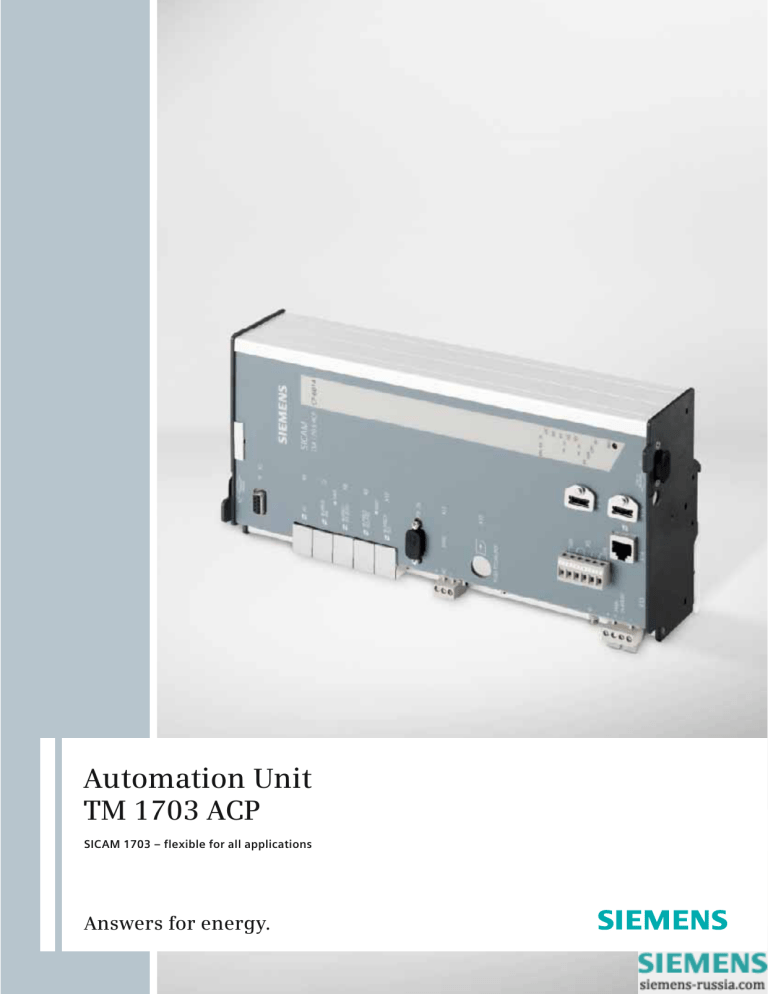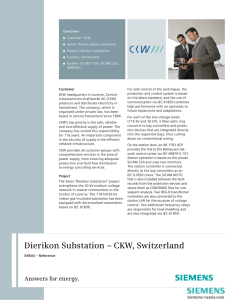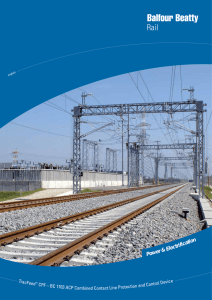
Automation Unit
TM 1703 ACP
SICAM 1703 – flexible for all applications
Answers for energy.
Outstanding performance:
TM 1703 ACP
Rising demands for efficiency in nearly all processes require increasingly innovative
automation solutions to achieve a more comprehensive and safer utilization of primary
equipment. A prerequisite for this is automation systems such as TM 1703 ACP with
various communications interfaces and peripheral elements that can be expanded
by adding modules.
Automate simply – with TM 1703 ACP
Highly complex yet fully transparent automation
solutions are no problem with TM 1703 ACP, thanks
to a system concept that makes it possible to
combine automation and telecontrol in one device.
Its intelligent terminal modules is designed for easy
mounting on 35 mm DIN rails.
Versatility is essential
Wide transfer interfaces are systematically reduced
with TM 1703 ACP through direct connection of
actuators and sensors with wire cross-sections of
up to 2.5 mm². Binary input and output modules up
to 220 VDC also open up savings potential at interface level. For decentral input/output, individual
modules can be located remotely as much as 200 m
away from the master control element.
TM 1703 ACP puts everything on one card
Configuration and all parameters of the TM 1703 ACP
are stored on a flash card. This means that in the
event of a fault, a replacement device can be put
into operation in seconds – without a PC or resetting
of parameters. This advantage, together with the
comprehensive remote diagnostic functions, helps
you minimize downtimes.
TM 1703 ACP understands your system
You can use a wide range of different media for local
and long-distance communication. TM 1703 ACP
functions with IEC standards 60870-5-101/103/104
and IEC 61850 for consistent addressing from
acquisition to output. Especially noteworthy is the
possibility of offering client and server functionality
on only one Ethernet interface. This interface was
certified by an independent laboratory to verify
interoperability. Numerous third party protocols also
facilitate seamless integration in existing automation
networks and the protection of existing investments.
TOOLBOX II: Consistently simple engineering
All engineering activities, from system diagnostics
to online testing, can also be carried out extremely
efficiently from remote locations. The close interfacing
with design tools such as ELCAD ensures consistent
documentation of the entire system, while the user
programs for closed- and open-loop control functions
are created in CAEx plus according to IEC 61131-3,
thereby minimizing the time and effort needed for
training.
Configurations
Process control system
TOOLBOX II
TM 1703 ACP
NTP
Central unit:
– Local input/output
– Central processing
TM 1703 ACP
– Data node
– Front end
– Gateway
TM 1703 ACP
TM 1703 ACP
TM 1703 ACP
– Turbine controller
– Power plant management
– Automation & control
TC substation:
– Local processing
– Decentralized
acquisition
Station control unit:
– Process coupling
(serial, wide)
– Node function
– Automatic functions
IEC 60870-5-104, IEC 61850
Practical applications of TM 1703 ACP
A TM 1703 ACP is an automation unit within the
SICAM 1703 system family, consisting of the master
control element and the peripheral elements that
can be expanded by adding modules and arranged
in distributed locations.
Master control element
■ Up to four communications interfaces
via insertable serial interface modules for:
– serial communication (point-to-point,
multipoint, and dial-up traffic)
– LAN/WAN (Ethernet)
– Profibus DP
■ Interfacing of up to 16 peripheral elements
via the serial Ax-1703 peripherals bus (16 mbps)
■ Function diagram design according to
IEC 61131-3 with CAEx plus for open-loop and
closed-loop control functions
■ Configurable telecontrol functions with and
without time tagging
■ Time synchronization via minute pulse,
time signal receiver, serial communications
link or NTP server (LAN/WAN)
■ Parameter setting, diagnostics, and testing by
TOOLBOX II, both locally or from remote locations
■ Storing of parameters and firmware on flash card
Peripheral element
■ One peripheral element consists of a power supply,
peripheral interface and up to eight I/O modules
■ Direct connection of the signal cables via pull-off
screw terminals
■
■
output of process data
Exchange of process data with the master control
element via the serial Ax-1703 peripheral bus
Technical data
■ Protocols: IEC 60870-5-101, 103, 104,
IEC 61850, Profibus DP, SAT SSI, SAT PCMBA,
Modbus, DNP 3.0, IEC 61107, ...
■ Closed- and open-loop control function:
512 kB for user program, about 50,000 variables
and signals, of which 2,000 buffered,
250 buffered setpoint values
■ EMC: IEC 60870-2, IEC 60255, IEC 61000,
EN 50082, ...
■ Supply voltage:
Master control element: 24 – 60 VDC + 30 %/– 20 %
Peripheral element: 24 – 60 VDC + 30 %/– 25 %;
110 – 220 VDC + 25 %/– 25 %
■ Temperature range:
Master control element: – 25 ... + 65 °C
(depending on equipment)
Peripheral element: – 25 ... + 70 °C
■ Dimensions:
Master control element: 306 x 155 x 75 mm
Peripheral element: 630 x 127 x 72 mm =
fully configured peripheral element with
8 I/O modules
Technical data
Type designation
Order designation
Description
Master control element
CP-6014/CPCX65
6MF11130GA140AA0
System functions, processing and communication
Flash card
Flash card
6MF12131GA050AA0
Memory card for parameters and firmware
Power supply
PS-6630
6MF11130GG300AA0
Power supply module 24 – 60 VDC EMC+
PS-6632
6MF11130GG320AA0
Power supply module 110 – 220 VDC EMC+
Periphery interfacing
PE-6410
6MF11130GE100AA0
Periphery interfacing for A x 1703 electrical peripherals bus
PE-6411
6MF11130GE110AA0
Periphery interfacing for A x 1703 optical peripherals bus
PE-6412
6MF11130GE120AA0
Periphery interfacing for A x 1703 peripherals bus 2 x optical*)
DI-6100
6MF11130GB000AA0
Binary input 2 x 8, 24–60 VDC
DI-6101
6MF11130GB010AA0
Binary input 2 x 8, 110–220 VDC
DI-6102
6MF11130GB020AA0
Binary input 2 x 8, 24–60 VDC 1 ms
DI-6103
6MF11130GB030AA0
Binary input 2 x 8, 110/220 VDC 1 ms
Peripheral elements
I/O modules
Direct transformer input
Bus Interface Module
Cables
DI-6104
6MF11130GB040AA0
Binary input 2 x 8, 220 VDC
DO-6200
6MF11130GC000AA0
Binary output transistor 2 x 8, 24–60 VDC
DO-6212
6MF11130GC120AA0
Binary output relay 1 x 8, 24–220 VDC, 230 VAC
DO-6220
6MF11130GC200AA0
Command output basic module
DO-6221
6MF11130GC210AA0
Command output basic module with measurement
DO-6230
6MF11130GC230AA0
Command output relay module
AI-6300
6MF11130GD000AA0
Analog input 2 x 2, ± 20 mA/± 10 mA/± 10 V
AI-6307
6MF11130GD070AA0
Analog input 2 x 2, ± 5 mA
AI-6308
6MF11130GD080AA0
Analog input 2 x 2, ± 1 mA/2 mA
AI-6310
6MF11130GD100AA0
Analog input 2 x 2 Pt100
AO-6380
6MF11130GD800AA0
Analog output 4 x ±20 mA/±10 mA/±10 V
TE-6420
6MF11130GE200AA0
Speed measurement 2 x 2 5/24 VDC/NAMUR
TE-6450
6MF11130GE500AA0
Position measurement 2 x 2 SSI/RS422
AI-6303
6MF11130GD030AA0
Direct transformer input (4 x 220 V, 3 x 6 A)
AI-6304
6MF11130GD040AA0
Direct transformer input (4 x 220 V, 3 x 6 A) 2 x optical*)
CM-0843
6MF11110AJ430AA0
A x 1703-Bus interface electrical
CM-0842
6MF11110AJ420AA0
A x 1703-Bus interface 4-way, optical fiber
T41-252
6MF13040BC520AA1
Patch cable CAT5 3 m
TC6-203
6MF13130GC030AA1
USB cable 3 m
SM-2551
6MF10130CF510AA0
Serial interface processor 2 serial interfaces (SI)
SM-2556
6MF10130CF560AA0
Network interface Ethernet 10/100TX
Protocol elements (hardware)
CPU (max. 2)
SM-2557
6MF10130CF570AA0
Dual Network interface Ethernet 10/100TX
SM-2545
6MF10110CF450AA0
Profibus interface
Submodule for SM-2556
SM-0551
6MF10130AF510AA0
Serial interface processor 1 SI (configurable on SM-2556)
Patch Plug (1 x per SI)
CM-2860
6MF12110CJ600AA0
Patch Plug Standard V28, Ethernet
CM-2869
6MF12112CJ600AA0
Patch Plug Profibus
CE-0700
6MF11020BC000AA0
V.23 Leased line modem
CE-0701
6MF11020CA810AA0
VFT channel modem
CM-0827
6MF11110AJ270AA0
Converter V28/optical
CM-0829
6MF11112AJ200AA0
Converter RS232/RS422; RS485
Accessories
Modems
Converters
*) only in combination with AK 1703 ACP in redundancy configurations
TM 1703 ACP – The advantages at a glance
TM 1703 ACP offers you automation with integrated
telecontrol for hydroelectric power stations (such
as the TC 1703 turbine controller), distribution
and transmission of electric power, oil and gas
pipelines, traffic (railroads, tunnels, etc.).
■ TM 1703 ACP provides powerful communication
with up to four serial interfaces, serial and
LAN/WAN communication according to
IEC 60870-5-101/103/104, IEC 61850,
Profibus DP, and many third-party protocols.
■ Simple engineering thanks to the creation of
open-loop and closed-loop control functions
according to IEC 61131-3, object orientation,
and consistent data management, as well as the
option to perform all engineering tasks from
remote locations as well.
■
Simplified service through storing of parameters
and firmware on flash card; thus modules can
be replaced via plug & play, even without a tool.
■ TM 1703 ACP, the intelligent terminal on 35-mm
rails: direct connection of actuators and sensors
through wire cross-sections of up to 2.5 mm2,
distributable peripherals, and binary input/output
also for 110/220 VDC.
■
Published by and copyright © 2009:
Siemens AG
Energy Sector
Freyeslebenstrasse 1
91058 Erlangen, Germany
Siemens AG
Energy Sector
Power Distribution Division
Energy Automation
Humboldtstrasse 59
90459 Nuremberg, Germany
www.siemens.com/energy-automation
For more information, please contact
our Customer Support Center.
Phone: +49 180/524 70 00
Fax:
+49 180/524 24 71
(Charges depending on provider)
E-mail: support.energy@siemens.com
Power Distribution Division
Order No. E50001-G720-A143-X-4A00
Printed in Germany
Dispo 06200
TH 345-090252 480301 WS 04093.0
Printed on elementary chlorine-free bleached paper.
All rights reserved.
Trademarks mentioned in this document
are the property of Siemens AG, its affiliates,
or their respective owners.
Subject to change without prior notice.
The information in this document contains general
descriptions of the technical options available, which
may not apply in all cases. The required technical
options should therefore be specified in the contract.
www.siemens.com/energy




